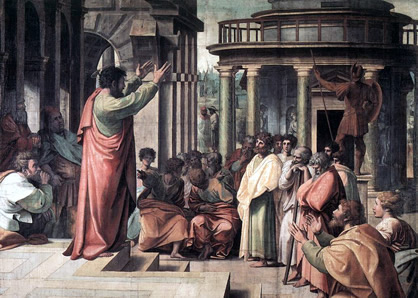Laodicea (Denizli - Pamukkale) Col. 2:1;4:13-16, Rev. 1:11;3:14
The last of the seven churches of Book of Revelation was that of
Laodicea. As a crossroad of two important roads, this city had an
important commercial and logistical position. The road that carried
St. Johns letter began at Ephesus, and moved north through Smyrna
and Pergamum
 before
turning east to Thyatira.
before
turning east to Thyatira.
Dropping due south, the letters were carried to Sardis, then
southeast to Philadelphia and finally Laodicea. Evidence of the
ancient road demonstrates that it continued to Colossae and
eventually to the Mediterranean port at Attalia (Antalya).
Intersecting with the Pergamum Attalia road was an inland roadway
from Cappadocia via Apamea (due east of Laodicea). This road gently
eased down to the coast at Ephesus, some 160
 kilometers
away. Ten miles east of the city lay the remains of Colossae, an
important city in the writing and ministry of the St. Paul.
kilometers
away. Ten miles east of the city lay the remains of Colossae, an
important city in the writing and ministry of the St. Paul.
Established in the C3 BCE by the Seleucid Antiochus II, the city was
named after his wife Laodicea. Built on the Lycus Tributary of the
Meander River, it was surnamed Laodicea on Lycus, to distinguish it
from other similarly named cities. The city was apparently addressed
with the nearby cities of Hierapolis and Colossae (Col. 2:1;
4:13-16) and was no doubt linked in trade and commerce with those
cities.
Though reasonably strong from the trade in what Strabo referred to
as raven-black wool and its thriving agricultural base, the city did
need the assistance of Rome after an earthquake disabled the city in
60 CE, according to Tacitus. The garment industry recovered, and
competed with
 Hierapolis
and Colossae for the textile manufacture and sale.
Hierapolis
and Colossae for the textile manufacture and sale.
There was also development of a medical industry, based on the eye
salves and Phrygian powders used in eye treatment (cp. Rev.
3:15-16). The banking and money exchange industry also thrived in
the city, an ironic reality of the city that was called poor and
naked and blind!
Positioned in the Lycus Valley a few miles from the hot calcium
waters of modern Pamukkale, the tell affords a view to the north and
east of the hot waters that pour out of the earth, and the distant
snow capped mountains to the south. Drawing the hot water from a
distance of more than four miles away, the water would arrive to the
city lukewarm, and need to be reheated. Many have noted the irony of
Rev. 3:15.

The church of Laodicea was begun by Epaphras while St. Paul was at
Ephesus (cp. Acts 19:10). The New Testament offers no direct
evidence of a visit by St. Paul to the city, though he refers to
believers there in the letter to Colossae. The letter to Laodicea
did not survive (Col. 4:16).
Biblical Sites in Turkey List


